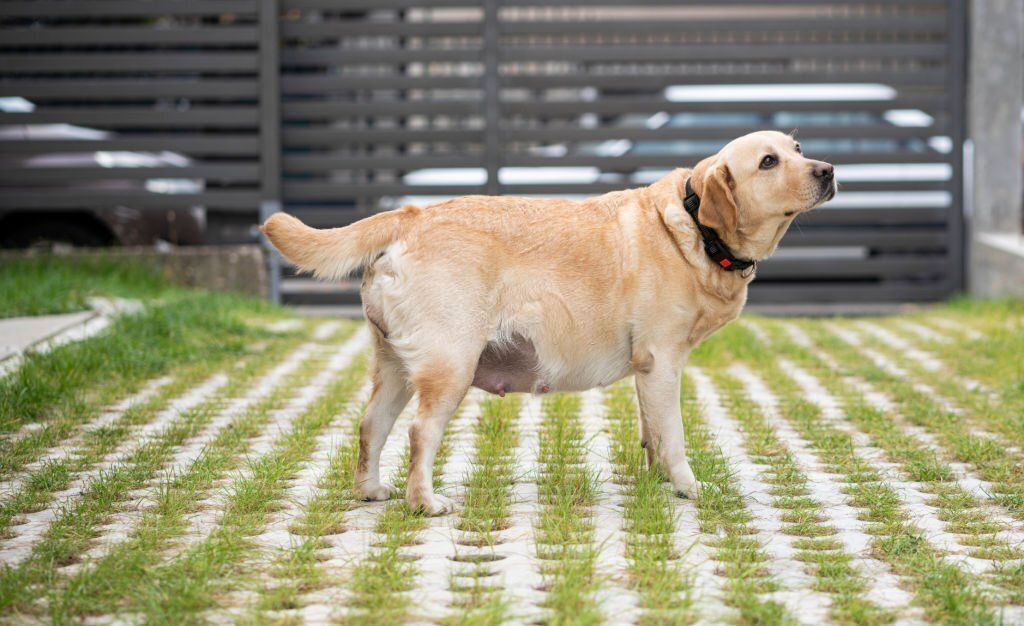
If your dog is pregnant for the first time, you might be wondering how long it will take for the puppies to develop. This information is important so you can prepare for the birth and estimate when it might happen. Some people think that every dog should have at least one litter of puppies, but that's not necessarily true. It depends on the dog's instincts, and some dogs may never show any interest in being a mother. If you want to know how long are dogs pregnant, continue reading this article.
Understanding the Reproductive Cycle of Dogs
The reproductive cycle of dogs plays a vital role in the process of breeding and the birth of puppies. It is important for dog owners and breeders to have a clear understanding of the different stages involved in the female dog's reproductive cycle. By being aware of these stages, they can effectively plan for mating, pregnancy, and the care of the mother and her puppies.
The reproductive cycle in female dogs consists of four main stages: proestrus, estrus, diestrus, and anestrus.
- Proestrus: This is the initial stage of the reproductive cycle and typically lasts for about 9 to 10 days. During this phase, the female dog's body prepares for potential mating. The vulva swells, and there may be some vaginal bleeding. However, the female is not receptive to males during this time.
- Estrus: Also known as the "heat" stage, estrus typically lasts for about 7 to 10 days, although it can vary between individuals. This is the period when the female is fertile and receptive to mating. The vaginal bleeding decreases, and the vulva returns to its normal size. Female dogs may exhibit certain behavioral changes during this phase, such as increased friendliness, restlessness, and attraction to males.
- Diestrus: Diestrus follows estrus and usually lasts for around 60 to 90 days. If the female dog has successfully mated during estrus, this stage marks the gestation period or pregnancy. Hormonal changes occur, and the female's body prepares for supporting the developing embryos. If mating did not occur, the female will go through a period of false pregnancy, where she may exhibit signs of pregnancy despite not being pregnant.
- Anestrus: Anestrus is the resting phase of the reproductive cycle and typically lasts for about 4 to 5 months. During this time, the female dog's reproductive system rests and prepares for the next proestrus stage. Hormone levels are low, and the female is not receptive to mating.
By understanding these stages of the reproductive cycle, dog owners and breeders can make informed decisions regarding breeding, pregnancy, and the overall health and care of their female dogs. It is important to consult with a veterinarian for guidance and assistance throughout the reproductive cycle to ensure the well-being of both the mother and her puppies.
How to Identify if Your Dog Is Pregnant
Determining if your dog is pregnant is an important step in providing proper care and support during this special time. Just like humans, dogs go through a gestation period when they carry and nurture their puppies. While it may seem challenging to detect pregnancy in dogs, there are several signs and symptoms you can look for to confirm if your furry friend is expecting.
Changes in Behavior:
One of the first indicators of pregnancy in dogs is changes in behavior. Your dog may become more affectionate and seek additional attention from you. She might exhibit nesting behavior by rearranging bedding or looking for a quiet and comfortable spot to rest. Additionally, pregnant dogs may display increased appetite and water intake, as well as slight weight gain. However, it's important to note that these changes can also be attributed to other health conditions, so it's crucial to consult a veterinarian for an accurate diagnosis.
Physical Changes:
Physical changes in your dog's body can also provide clues about her pregnancy. Around three weeks after mating, you may notice her nipples becoming enlarged and pink. This is known as "pinking up" and is a clear indication of hormonal changes associated with pregnancy. As the pregnancy progresses, her abdomen will gradually expand, and you may be able to feel the growing puppies if you gently press on her belly. However, it's essential to exercise caution and avoid applying excessive pressure to prevent any harm to the developing puppies.
Veterinary Examination:
If you suspect that your dog might be pregnant, it is highly recommended to schedule a veterinary examination. A veterinarian can conduct a thorough physical examination, palpate the abdomen to check for the presence of puppies, and perform diagnostic tests like ultrasound or X-rays to confirm the pregnancy. These professional assessments are crucial to ensure the health and well-being of both the mother and her puppies.

Hormonal and Lab Tests:
Another method to determine pregnancy in dogs is through hormonal or laboratory tests. Your veterinarian can perform a blood test to detect the presence of relaxin hormone, which is produced during pregnancy. This hormone can be detected as early as 20-25 days after mating, offering an early confirmation of pregnancy. Additionally, there are at-home pregnancy kits available for dogs that test for relaxin hormone levels in urine. However, it's important to follow the instructions carefully and consult with your vet for accurate interpretation of the results.
Ultrasound Examination:
Ultrasound examination is a non-invasive and safe technique that can be used to confirm pregnancy in dogs. It allows the veterinarian to visualize the developing puppies in the uterus. This method is usually performed around 25-35 days after mating and provides valuable information about the number of puppies, their size, and their viability. Ultrasound examinations also help detect any potential complications or abnormalities that may require further attention.
X-ray Examination:
X-ray examination is commonly performed during the later stages of pregnancy, typically around day 45 to day 58 after mating. This diagnostic tool allows the veterinarian to visualize the skeletal structures of the puppies. X-rays are especially useful for determining the exact number of puppies, their position, and size. It is also helpful in identifying potential problems like overcrowding or malpositioning of the puppies before delivery.
Palpation Examination Test
Once an X-ray examination has been performed to determine the number and position of the puppies in your dog's uterus, a veterinarian may also conduct a palpation test as a complementary method. Palpation involves manually feeling the dog's abdomen to assess the size, shape, and movement of the puppies.
During the palpation test, the veterinarian gently and carefully places their hands on the dog's abdomen. They will use their fingers to feel for the presence of individual puppies and evaluate their positions. This hands-on examination allows the veterinarian to gather additional information about the pregnancy and assess the overall health of the puppies.
Palpation is typically performed during the later stages of pregnancy, around day 28 to day 35 after mating. By this time, the puppies have developed sufficiently to be palpable. However, it's crucial to note that palpation should only be performed by a skilled and experienced veterinarian to avoid any potential harm to the mother or the puppies.
During the palpation test, the veterinarian may be able to determine the approximate size of the puppies, their overall condition, and their movement. They can assess if the puppies are positioned correctly and if there are any signs of distress or complications. If any abnormalities or concerns are detected during the palpation, the veterinarian can take appropriate measures to ensure the well-being of both the mother and the puppies.
Identifying if your dog is pregnant involves paying close attention to changes in behavior, and physical signs, and seeking professional veterinary assistance. While behavioral changes and physical indications provide initial hints, a veterinarian can provide a definitive diagnosis through physical examination, hormonal tests, ultrasound, or X-ray examinations, and palpation tests. By recognizing the signs of pregnancy in your dog, you can ensure appropriate care and prepare for the arrival of adorable puppies into your family.
How Long Are Dogs Pregnant: Understanding the Gestation Period
Understanding the gestation period of dogs is essential for dog owners and breeders alike. The gestation period refers to the duration of pregnancy, during which the mother carries and nurtures her developing puppies. Knowing how long dogs are pregnant enables proper planning and preparation for the upcoming birth.
Average Duration of Dog Pregnancy:
On average, dogs have a gestation period that lasts approximately 63 days. However, it's important to note that this is an average figure, and individual dogs may experience slightly shorter or longer pregnancies. The actual duration can vary depending on various factors, including the breed of the dog and the number of puppies she is carrying.
Factors Affecting Gestation Period:
Several factors can influence the length of the gestation period in dogs. Breed plays a significant role, as smaller breeds tend to have shorter pregnancies compared to larger breeds. Generally, smaller breeds may have a gestation period of around 58 to 63 days, while larger breeds may have pregnancies lasting 63 to 68 days.
The number of puppies the dog is carrying can also impact the gestation period. If a dog is carrying a smaller litter, the pregnancy might be shorter. Conversely, if a dog is expecting a larger litter, the gestation period may be slightly longer to allow for proper development of all the puppies.
Important Considerations during the Gestation Period:
During the gestation period, it is crucial to provide appropriate care and support to ensure the health and well-being of both the mother and her developing puppies. Here are some important considerations:
- Nutrition: Proper nutrition is essential during pregnancy. It is recommended to switch the mother to a high-quality, balanced diet formulated specifically for pregnant and lactating dogs. Consult with a veterinarian to determine the appropriate diet and feeding schedule for your pregnant dog.
- Exercise: Moderate exercise is beneficial for pregnant dogs, as it helps maintain muscle tone and overall health. However, it's important to avoid excessive physical exertion or strenuous activities that could potentially harm the mother or the puppies.
- Veterinary Care: Regular veterinary check-ups are vital during pregnancy. The veterinarian can monitor the progress of the pregnancy, ensure the mother's health, and identify any potential complications. They may also perform diagnostic tests, such as ultrasounds, to assess the development and well-being of the puppies.
- Nesting Area: As the due date approaches, create a comfortable and safe nesting area for the mother. Provide a quiet space where she can give birth and nurse her puppies.
- Emotional Support: Pregnant dogs may display changes in behavior or temperament. Provide reassurance, attention, and emotional support to help them feel secure and comfortable during this time.
What are the Stages of Dog Pregnancy?
A dog pregnancy is a remarkable journey that consists of several distinct stages as the puppies develop within the mother's womb. Understanding these stages is crucial for dog owners and breeders to provide appropriate care and support throughout the pregnancy.
Stage 1: Proestrus and Estrus:
The first stage of dog pregnancy begins with proestrus, which is characterized by the presence of vaginal bleeding. During this phase, the female dog may attract male dogs but is not yet receptive to mating. Proestrus typically lasts for about 9 to 10 days.
Following proestrus, the female enters the estrus stage, commonly known as the "heat" cycle. During this period, the bleeding diminishes, and the dog becomes sexually receptive. This is the optimal time for mating to occur. The duration of estrus can vary but generally lasts for about 5 to 9 days.

Stage 2: Mating and Fertilization:
If successful mating takes place during the estrus stage, the male's sperm fertilizes the female's eggs, leading to pregnancy. Fertilization typically occurs within 48 to 72 hours after mating. It is important to note that conception does not always guarantee pregnancy, as the fertilized eggs still need to implant in the uterus for successful development.
Stage 3: Gestation:
The gestation period is the stage of active pregnancy, during which the developing puppies grow within the mother's uterus. This stage is characterized by significant physical and hormonal changes.
During the first few weeks of gestation, the embryos divide and form into blastocysts. These blastocysts then implant into the uterine lining. This process is known as implantation and occurs around day 20 to 24 after mating.
As gestation progresses, the puppies undergo rapid development. By the end of the second month, all major organs and body systems have formed. The mother's abdomen gradually expands as the puppies grow, and the veterinarian may be able to palpate the puppies' movements during this stage.

Stage 4: Pre-Labor and Whelping:
As the due date approaches, the mother dog enters the pre-labor stage. This is characterized by nesting behavior, where the dog starts seeking out a comfortable and secure place to give birth. She may become restless, pant more frequently, and exhibit a decrease in appetite.
During whelping, or the act of giving birth, the mother experiences uterine contractions to expel the puppies. Each puppy is born within a protective amniotic sac, which the mother typically breaks and cleans off. The process of whelping can last several hours, with intervals between each puppy's delivery.
Stage 5: Postpartum:
After the delivery of all the puppies, the mother enters the postpartum stage. During this time, she focuses on caring for and nursing her newborn puppies. The mother will provide milk to nourish the puppies, and she will keep them warm and clean. It's crucial to monitor the mother's health during this stage and provide her with a nutritious diet to support her lactation.
Conclusion
In conclusion, understanding the stages of dog pregnancy and how long dogs are pregnant is crucial for dog owners and breeders. The gestation period of dogs typically lasts around 63 days, although it can vary depending on factors such as breed and litter size. By recognizing the stages of proestrus, estrus, gestation, pre-labor, whelping, and postpartum, we can provide the necessary care and support to ensure the health and well-being of both the mother and her puppies. Consulting with a veterinarian throughout the pregnancy journey is essential to monitor the progress, address any concerns, and ensure a successful and safe delivery.






